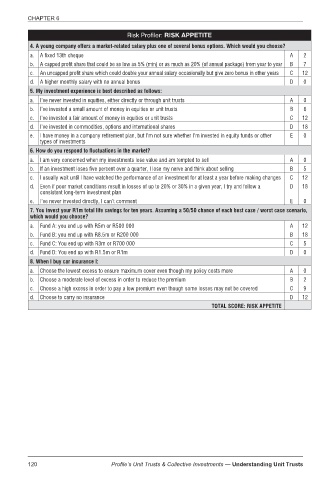Page 122 - Profile's Unit Trusts & Collective Investments - March 2025
P. 122
CHAPTER 6
Risk Profiler: RISK APPETITE
4. A young company offers a market-related salary plus one of several bonus options. Which would you choose?
a. A fixed 13th cheque A 2
b. A capped profit share that could be as low as 5% (min) or as much as 20% (of annual package) from year to year B 7
c. An uncapped profit share which could double your annual salary occasionally but give zero bonus in other years C 12
d. A higher monthly salary with no annual bonus D 0
5. My investment experience is best described as follows:
a. I’ve never invested in equities, either directly or through unit trusts A 0
b. I’ve invested a small amount of money in equities or unit trusts B 6
c. I’ve invested a fair amount of money in equities or unit trusts C 12
d. I’ve invested in commodities, options and international shares D 18
e. I have money in a company retirement plan, but I’m not sure whether I’m invested in equity funds or other E 0
types of investments
6. How do you respond to fluctuations in the market?
a. I am very concerned when my investments lose value and am tempted to sell A 0
b. If an investment loses five percent over a quarter, I lose my nerve and think about selling B 5
c. I usually wait until I have watched the performance of an investment for at least a year before making changes C 12
d. Even if poor market conditions result in losses of up to 20% or 30% in a given year, I try and follow a D 18
consistent long-term investment plan
e. I’ve never invested directly, I can’t comment E 0
7. You invest your R1m total life savings for ten years. Assuming a 50/50 chance of each best case / worst case scenario,
which would you choose?
a. Fund A: you end up with R5m or R500 000 A 12
b. Fund B: you end up with R8.5m or R200 000 B 18
c. Fund C: You end up with R3m or R700 000 C 5
d. Fund D: You end up with R1.5m or R1m D 0
8. When I buy car insurance I:
a. Choose the lowest excess to ensure maximum cover even though my policy costs more A 0
b. Choose a moderate level of excess in order to reduce the premium B 2
c. Choose a high excess in order to pay a low premium even though some losses may not be covered C 9
d. Choose to carry no insurance D 12
TOTAL SCORE: RISK APPETITE
120 Profile’s Unit Trusts & Collective Investments — Understanding Unit Trusts

